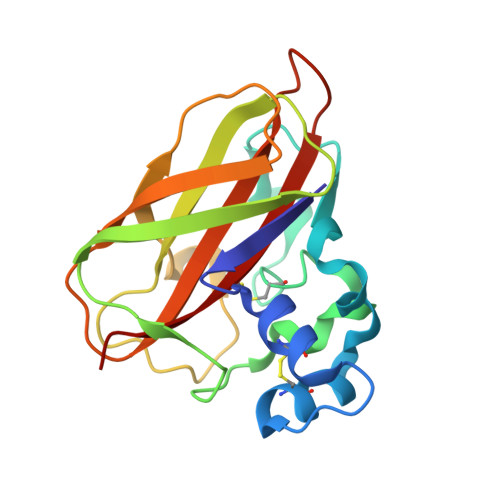Structural and Functional Analysis of a Lytic Polysaccharide Monooxygenase Important for Efficient Utilization of Chitin in Cellvibrio Japonicus
Forsberg, Z., Nelson, C.E., Dalhus, B., Mekasha, S., Loose, J.S.M., Rohr, A.K., Eijsink, V.G.H., Gardner, J.G., Vaaje-Kolstad, G.(2016) J Biological Chem 291: 7300
- PubMed: 26858252
- DOI: https://doi.org/10.1074/jbc.M115.700161
- Primary Citation of Related Structures:
5FJQ - PubMed Abstract:
Cellvibrio japonicusis a Gram-negative soil bacterium that is primarily known for its ability to degrade plant cell wall polysaccharides through utilization of an extensive repertoire of carbohydrate-active enzymes. Several putative chitin-degrading enzymes are also found among these carbohydrate-active enzymes, such as chitinases, chitobiases, and lytic polysaccharide monooxygenases (LPMOs). In this study, we have characterized the chitin-active LPMO,CjLPMO10A, a tri-modular enzyme containing a catalytic family AA10 LPMO module, a family 5 chitin-binding module, and a C-terminal unclassified module of unknown function. Characterization of the latter module revealed tight and specific binding to chitin, thereby unraveling a new family of chitin-binding modules (classified as CBM73). X-ray crystallographic elucidation of theCjLPMO10A catalytic module revealed that the active site of the enzyme combines structural features previously only observed in either cellulose or chitin-active LPMO10s. Analysis of the copper-binding site by EPR showed a signal signature more similar to those observed for cellulose-cleaving LPMOs. The full-length LPMO shows no activity toward cellulose but is able to bind and cleave both α- and β-chitin. Removal of the chitin-binding modules reduced LPMO activity toward α-chitin compared with the full-length enzyme. Interestingly, the full-length enzyme and the individual catalytic LPMO module boosted the activity of an endochitinase equally well, also yielding similar amounts of oxidized products. Finally, gene deletion studies show thatCjLPMO10A is needed byC. japonicusto obtain efficient growth on both purified chitin and crab shell particles.
- From the Department of Chemistry, Biotechnology, and Food Science, Norwegian University of Life Sciences, 1432 Ås, Norway.
Organizational Affiliation:

















